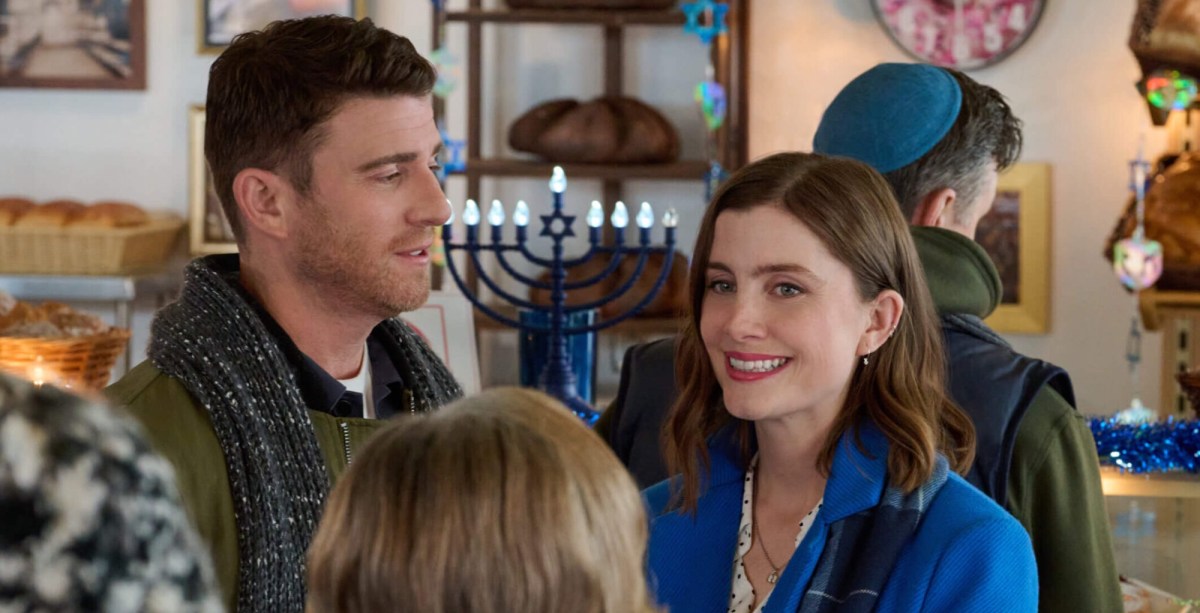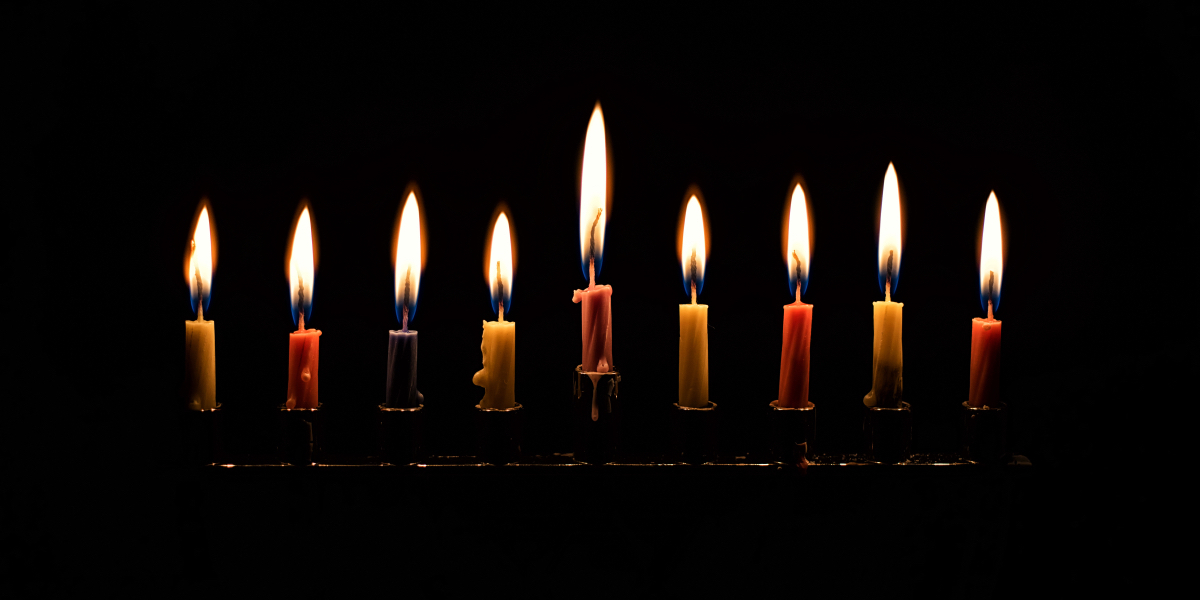I love being queer and Jewish. I love how deep and rich both traditions are. I love how both communities are multi-layered and multivocal. Judaism isn’t One Thing. Passover doesn’t celebrate One Story. The tradition speaks in a cacophony of voices that often contradict each other. As Jews (and as queers), we get to make meaning from and build on the traditions we have inherited.
I wrote Haggadah Min HaMeitzar as my contribution to the evolving conversation. When I set out to create the haggadah, I wanted to celebrate the history and depth of all of my identities and all of the traditions I have inherited, as a queer/nonbinary, environmentalist, and scholarly Jew. I also wanted to celebrate the multivocality of the haggadah itself. I intentionally made art in a variety of media (including mixed media!) to highlight that diversity. And I wrote a commentary with four voices corresponding to the four names of the holiday.
Chag HaCheirut (the Holiday of Freedom): Progressive and Queer

I spent a lot of time as a teenager worrying about whether it is okay to be queer and a religious Jew. I grew up in a very observant Conservative Jewish home. When I was 15, the rabbis who make decisions about Conservative Jewish law and practice addressed the question of ordaining openly gay rabbis. The proposed answers: No; yes with caveats; and yes without hesitation. The first two answers both passed. (Yes, they passed contradictory answers.) The final one narrowly failed the vote–because it was declared to be too radical for a simple majority rule. I spent many hours and shed many tears studying the rabbis’ essays and reviewing the texts they cited, trying to figure out where I fit in. The “yes with caveats” answer was rooted in straight supremacy and biphobia, but I wasn’t – at the time – satisfied with the way the “yes without hesitation” answer approached Jewish law and practice.
Nowadays, I don’t ask if it is okay to be queer and Jewish. I ask, “how can my queerness deepen my Judaism, and how can my Judaism deepen my queerness?” The painting above depicts the moment the Red Sea split. In the story in the Torah, the Israelites wind up at the Red Sea while being pursued by Pharaoh’s armies. They are trapped between the chariots approaching and the water in front of them, and they panic. Even Moses falls on his face. But there’s a midrash (stories rabbis have told to embellish the biblical stories, essentially rabbinic fanfiction) that says that the sea split when one Israelite, Nachshon son of Aminadav, walked into the water until it was above his nostrils — and that’s when the sea split. I depicted Nachshon as a nonbinary trans femme character, accompanied by a brief written addition to the midrash. Trans and nonbinary folks know what it means to walk into deep water, with the faith that we will make it through.
Chag HaAviv (the Springtime Holiday): Environmentalism
I work as an environmental planner helping FEMA empower local communities to reduce their risks and become more resilient. I think a lot about the environmental harm humanity has perpetrated, and the destruction that is already locked in due to climate change. I wanted to connect the themes of freedom and liberation with my fears about climate change and environmental degradation.
One of the first things we do in the seder ritual is break the middle matzah. I depicted the broken matzah as a broken earth — what is irreparably harmed? What can we stitch back together?
Chag HaMatzot (the Matzah Holiday): Embodiment
In general, I’m more comfortable in the sphere of concepts and ideas rather than tangible, corporeal bodies. But my Jewish, queer, and environmental traditions all challenge me to live fully into myself and my body. In this commentary, I sought to emphasize the parts of the Passover seder that ground us in the physicality of life — the harsh sting of the bitter herbs, the crunch of the matzah, the splash of water over our hands.
Water is a theme throughout the Passover seder. We wash our hands ritually — twice. We dip vegetables in salt water. We have water (or seltzer, symbolizing living water) in Miriam’s cup on the table. We talk about the splitting of the Red Sea, and of the Nile turning to blood. In this piece, I wanted to bring the theme of water into our own bodies. Our stories are water, our ritual is water, and we, too, are water. Water is life.
Chag HaPesach (Passover): Storytelling

And now I’m back to storytelling. The Passover seder is as much about how the story of the Exodus has been told over the millennia as it is about the story of the Exodus itself. Haggadah Min HaMeitzar is about how I approach the Jewish stories. It is deep and nuanced, and more than I could have included in one book. There are more questions than answers, and that’s how it should be.
This mixed media piece uses a (copy) of a page of Talmud to make the question mark. The text includes the Mishnah from 1800 or so years ago of the ma nishtana—the part of the seder little children to this day learn first. The Hebrew words around the edges are question words in Hebrew and Aramaic (the language of the Talmud): “what,” “why,” “how,” “really??” etc. The questions are more important than the answers.
I wrote Haggadah Min HaMeitzar because the queer, environmentalist, traditional haggadah I was searching for didn’t exist. I wrote it because I have grown beyond the question of whether I can be fully queer and fully Jewish and into the question of how being queer makes me more Jewish and how being Jewish makes me more queer. I wrote it because my voice—and all the marginalized voices I highlighted in the commentary — is valuable and part of the evolving story we continue to tell in each generation.
Min HaMeitzar means “from the narrows.” It is a phrase from Psalm118, where the psalmist cries out to God from the narrows, and God answers from a place of openness and abundance. It’s also a play on Mitzrayim (Egypt), so named because it was a narrow fertile strip adjacent to the Nile. Many commentators have talked about the spiritual metaphor of leaving the places that confine us and hold us back. This year, may we all leave those places, wading through deep waters if necessary, and move toward liberation for ourselves and each other.
Passover begins at sundown on Wednesday April 5, 2023. If you would like to use Haggadah Min HaMeitzar at your seder this year, you can order it from the publisher here. Prints of the art from the haggadah are also available. Or, let this article inspire you to write your own haggadah! No matter how you celebrate, chag sameach.










Comments
love seeing this here <3 thank you
Welcome to Autostraddle, G! What a way to start!!!!
This was so thoughtful and beautiful. I am a witchy type, myself, and finding religious community is something that is on my mind a lot right now. Because of that, I really enjoy hearing about queer people’s experience of religion, all different religions.
What is Miriam’s cup? I’ve looked at decades of feminist haggadot and have not run into this before.
Yooooo Gabriella it’s so good to see this (and you) on here!!! I love this article you wrote about your Haggadah—what a freaking accomplishment.
I’m no longer in JP as of a year and a half ago but I miss it dearly and it was always fun to run into you. Peace to you! -Rebecca
So nice to see you here too–thanks so much! We miss you in JP. I saw your crosswords in the Barnard mag! :-)
Great article and yasher koach on writing your own haggadah! After several years of pandemic seders with just my wife and kiddo or zooming into community seder — this year we travel back to a bigger family seder and I’m dreading using their traditional haggadah. I love that you wrote your own and that you are here to tell us about it.
Thanks for this!
Thank you so much for this! I find myself struggling right now, with creating a passover tradition that’s inclusive, that brings my majority goy 100% queer friend group with me. They’ve already embraced with gusto Purim and Sukkot and weekly Shabbats, but every year I decide I can’t take on Pesach. It’s hard to not just be inclusive but to actively bring folks into a tradition! Rather than just performing it? So this was really inspiring to me personally, not just the beautiful thoughts and art and conversations about the holiday, but also seeing it on Autostraddle. Thank you so much.
It’s such a challenge! And for so long, the answers have been to water things down or simplify them–but I think we can make the complexity and the depth approachable and relevant and valuable.
Thanks for sharing and for your kind thoughts! Best of luck making a meaningful Pesach that works for you.
This looks amazing!!! Is there any way to buy an online version as well as a print one? My wife and I have really enjoyed hosting hybrid seders since the pandemic, esp with some last minute guests, so having something in dual format would be super helpful. Thanks so much!!!
Thank you for creating this!!!
Hi Gabriella,
We got a copy of your Hagaddah and are looking forward to using it.
Yay! I’d love to hear your thoughts!